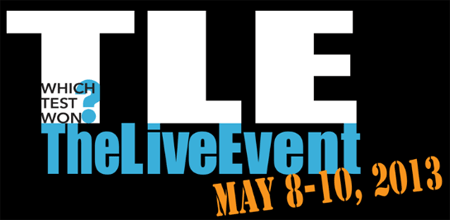 Last week, Which Test Won sponsored the inaugural The Live Event, in Austin. This was a wonderful event with more face-to-face time and hands-on assistance from industry experts than I have seen at any other event. We heard from experts such as Bryan & Jeffrey Eisenberg, Justin Cutroni of Google, Andy Edmonds of Ebay, and Nazli Yuzak of Dell. We also had excellent presentations from people in the trenches optimizing conversions every day, such as Joy Billings from Experian, Ophir Prusak from BlazeMeter, and Josh Berg from Wayfair.
Last week, Which Test Won sponsored the inaugural The Live Event, in Austin. This was a wonderful event with more face-to-face time and hands-on assistance from industry experts than I have seen at any other event. We heard from experts such as Bryan & Jeffrey Eisenberg, Justin Cutroni of Google, Andy Edmonds of Ebay, and Nazli Yuzak of Dell. We also had excellent presentations from people in the trenches optimizing conversions every day, such as Joy Billings from Experian, Ophir Prusak from BlazeMeter, and Josh Berg from Wayfair.
A great addition to this conference were one-on-one consultations with additional conversion gurus, including Conversion Scientist Brian Massey, Craig Smith & Nate Ende

Google’s Justin Cutroni, presenting at The Live Event in Austin, 2013.
of Trinity Insight, Justin Matsui of SLI Systems, and Michael Kelly of ClickMail Marketing. These consultations were fabulous opportunities to have a fresh set of eyes look at your site to offer insight.
Many Experts Are Better Than One
We all think we are doing a pretty good job at optimizing our web sites for the maximum value, but when you’re in a room with dozens of other conversion & testing experts, you’re always going to take away new things to do, as well as have some others that you were planning be reinforced. Here are some of my takeaways from the two-day event (in no particular order):
- For Ecommerce sites, make your Site Search bar large and prominent, right where the eye looks first. It’s been shown many times over that for online stores, visits where site search is used consistently convert at higher rates than visits without using site search. So encouraging people to search should result in a bump in conversion rates. Look to big boys like Zappos & Amazon if you need support on this.
- Ensure that your product pages have customer reviews on them. To quote Craig Smith, this “is a no brainer”. Pages with reviews convert much better than pages without. In my case, I have some small customers whose pages do not include reviews, partly because they worry about any potential negative reviews. But even negative reviews can help because they add validity to all of the reviews on the site.
- If you sell internationally, make sure your cart displays information properly for your audience. You can use your visitor’s IP Address and a GeoIP Locator service to determine your visitor’s location pretty accurately. So show the cart/order information in a format your visitor is used to. For example, in Europe, instead of a dollar sign to the left of the numbers, have pricing in Euros and put the Euro sign to the right. Also in Europe, a comma is used to separate dollars & cents, while a period is used as a thousands separator. And VAT is generally included in base pricing, instead of being added on at the end of the order as it is in the US.
- When designing marketing emails, always lead with a short snippet of text that describes the email in a way to help entice the open. Currently, about 70% of all email users still use some form of a preview pane. So they’ll see the first few words of each email. If the top of your message is something like “Click here for an html version of this message”, that is what will show in the preview area, and you’ve lost an opportunity to get them to open. If your message begins with a large graphic, get that snippet of text with the key offer or value of the message in first, so they see it before they open (or delete).
- Design your marketing emails with mobile in mind first. This is kind of an extension to the last one, but really drives the point, and the purpose home. With all the explosive growth in smartphone usage you’ve been reading about, it’s by far the greatest with email. So much email is read on smartphones these days, if your message does not display well there (and in the inbox summary, as described above), it will probably get deleted before the reader gets to his or her desktop.
- Take advantage of the new form fields in html5. There are great things that html5 brings to the table with respect to forms for any platform, but this came up specifically at the conference with respect to mobile usage. Many smartphones will present a keyboard tailored to the form field being used. So for example, while a type=”text” field will give you a normal keyboard, if you use a type=”email” an iPhone will give the user a keyboard with an @ sign and a period there as well to make it easier for them to enter their email without using shift keys. Mark Pilgrim has an excellent reference on html5 form fields at http://diveintohtml5.info/forms.html.
- Modify A/B test parameters slightly to get statistically significant results. We all want to run tests that can give us 95% confidence results in just a few days. But many smaller sites just don’t have the traffic to do that. Reducing the confidence level down to 90% can often dramatically reduce the traffic requirement to get there, without affecting your risk too much. Also, you can make multiple changes to the test page so that it will have a bigger impact. You may not learn exactly which component of the changed page was the primary cause, but you can achieve a version that yields higher conversions with confidence.
As always, mileage may vary. Every site is different, and therefore some of the things listed above may or may not have much effect. “Best Practices” are as a rule, just guidelines. You should test all changes to your site to make sure the changes did indeed have a positive impact on your site.
And finally, I’d strongly suggest you check out The Live Event next year. The benefits exceeded the cost of the conference many times over. Talk to the folks at Which Test Won to keep advised of upcoming event schedules.







